Evaluating Monetary Incentives in Management Accounting (MGT200, KOI)
VerifiedAdded on 2023/01/23
|8
|2088
|55
Essay
AI Summary
This essay explores the multifaceted role of monetary incentives in management accounting, examining their impact on employee motivation, productivity, and organizational success. The essay delves into the advantages of financial rewards, such as bonuses, profit sharing, and stock options, highlighting their potential to enhance employee loyalty, improve performance, and align individual goals with company objectives. It also critically analyzes the disadvantages, including increased costs, potential for demotivation, and the risk of fostering competition and burnout. Drawing on research from various authors, the essay provides a balanced perspective on the effectiveness of monetary incentives, emphasizing the importance of careful structuring to ensure fairness, promote teamwork, and avoid unintended consequences. The essay concludes that, while monetary incentives can be a powerful tool for motivation, their successful implementation requires a nuanced understanding of their potential benefits and drawbacks.
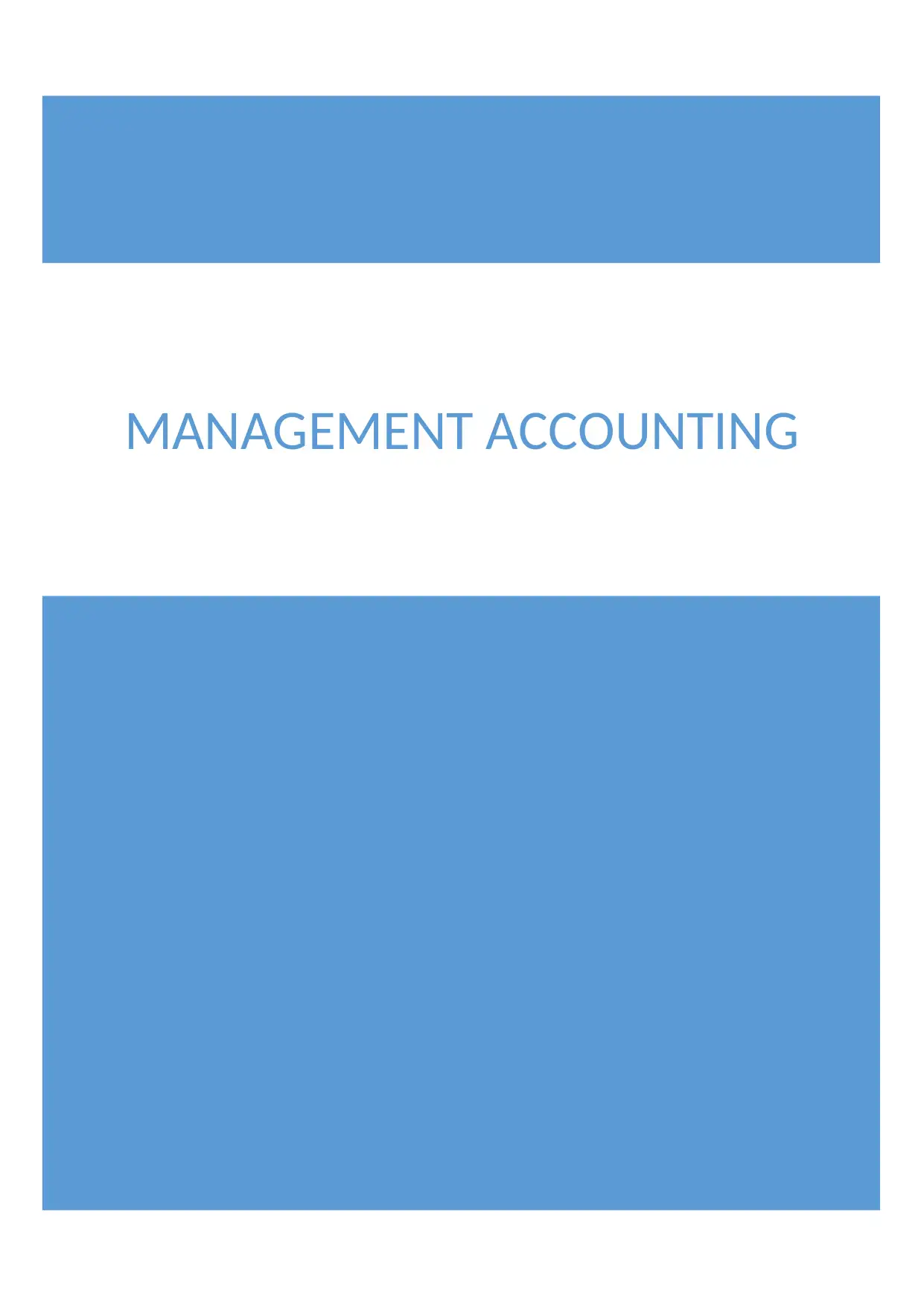
MANAGEMENT ACCOUNTING
Paraphrase This Document
Need a fresh take? Get an instant paraphrase of this document with our AI Paraphraser
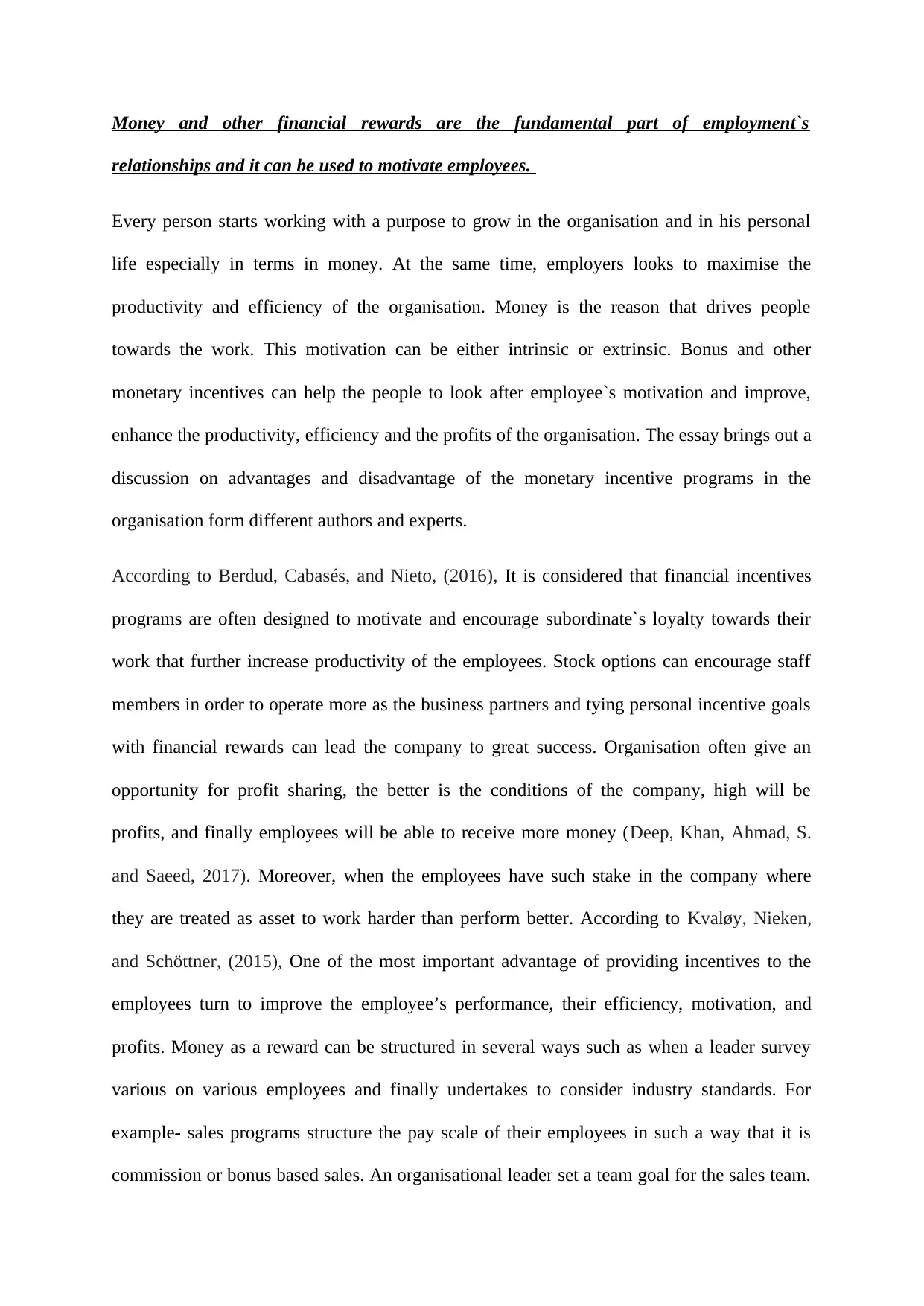
Money and other financial rewards are the fundamental part of employment`s
relationships and it can be used to motivate employees.
Every person starts working with a purpose to grow in the organisation and in his personal
life especially in terms in money. At the same time, employers looks to maximise the
productivity and efficiency of the organisation. Money is the reason that drives people
towards the work. This motivation can be either intrinsic or extrinsic. Bonus and other
monetary incentives can help the people to look after employee`s motivation and improve,
enhance the productivity, efficiency and the profits of the organisation. The essay brings out a
discussion on advantages and disadvantage of the monetary incentive programs in the
organisation form different authors and experts.
According to Berdud, Cabasés, and Nieto, (2016), It is considered that financial incentives
programs are often designed to motivate and encourage subordinate`s loyalty towards their
work that further increase productivity of the employees. Stock options can encourage staff
members in order to operate more as the business partners and tying personal incentive goals
with financial rewards can lead the company to great success. Organisation often give an
opportunity for profit sharing, the better is the conditions of the company, high will be
profits, and finally employees will be able to receive more money (Deep, Khan, Ahmad, S.
and Saeed, 2017). Moreover, when the employees have such stake in the company where
they are treated as asset to work harder than perform better. According to Kvaløy, Nieken,
and Schöttner, (2015), One of the most important advantage of providing incentives to the
employees turn to improve the employee’s performance, their efficiency, motivation, and
profits. Money as a reward can be structured in several ways such as when a leader survey
various on various employees and finally undertakes to consider industry standards. For
example- sales programs structure the pay scale of their employees in such a way that it is
commission or bonus based sales. An organisational leader set a team goal for the sales team.
relationships and it can be used to motivate employees.
Every person starts working with a purpose to grow in the organisation and in his personal
life especially in terms in money. At the same time, employers looks to maximise the
productivity and efficiency of the organisation. Money is the reason that drives people
towards the work. This motivation can be either intrinsic or extrinsic. Bonus and other
monetary incentives can help the people to look after employee`s motivation and improve,
enhance the productivity, efficiency and the profits of the organisation. The essay brings out a
discussion on advantages and disadvantage of the monetary incentive programs in the
organisation form different authors and experts.
According to Berdud, Cabasés, and Nieto, (2016), It is considered that financial incentives
programs are often designed to motivate and encourage subordinate`s loyalty towards their
work that further increase productivity of the employees. Stock options can encourage staff
members in order to operate more as the business partners and tying personal incentive goals
with financial rewards can lead the company to great success. Organisation often give an
opportunity for profit sharing, the better is the conditions of the company, high will be
profits, and finally employees will be able to receive more money (Deep, Khan, Ahmad, S.
and Saeed, 2017). Moreover, when the employees have such stake in the company where
they are treated as asset to work harder than perform better. According to Kvaløy, Nieken,
and Schöttner, (2015), One of the most important advantage of providing incentives to the
employees turn to improve the employee’s performance, their efficiency, motivation, and
profits. Money as a reward can be structured in several ways such as when a leader survey
various on various employees and finally undertakes to consider industry standards. For
example- sales programs structure the pay scale of their employees in such a way that it is
commission or bonus based sales. An organisational leader set a team goal for the sales team.
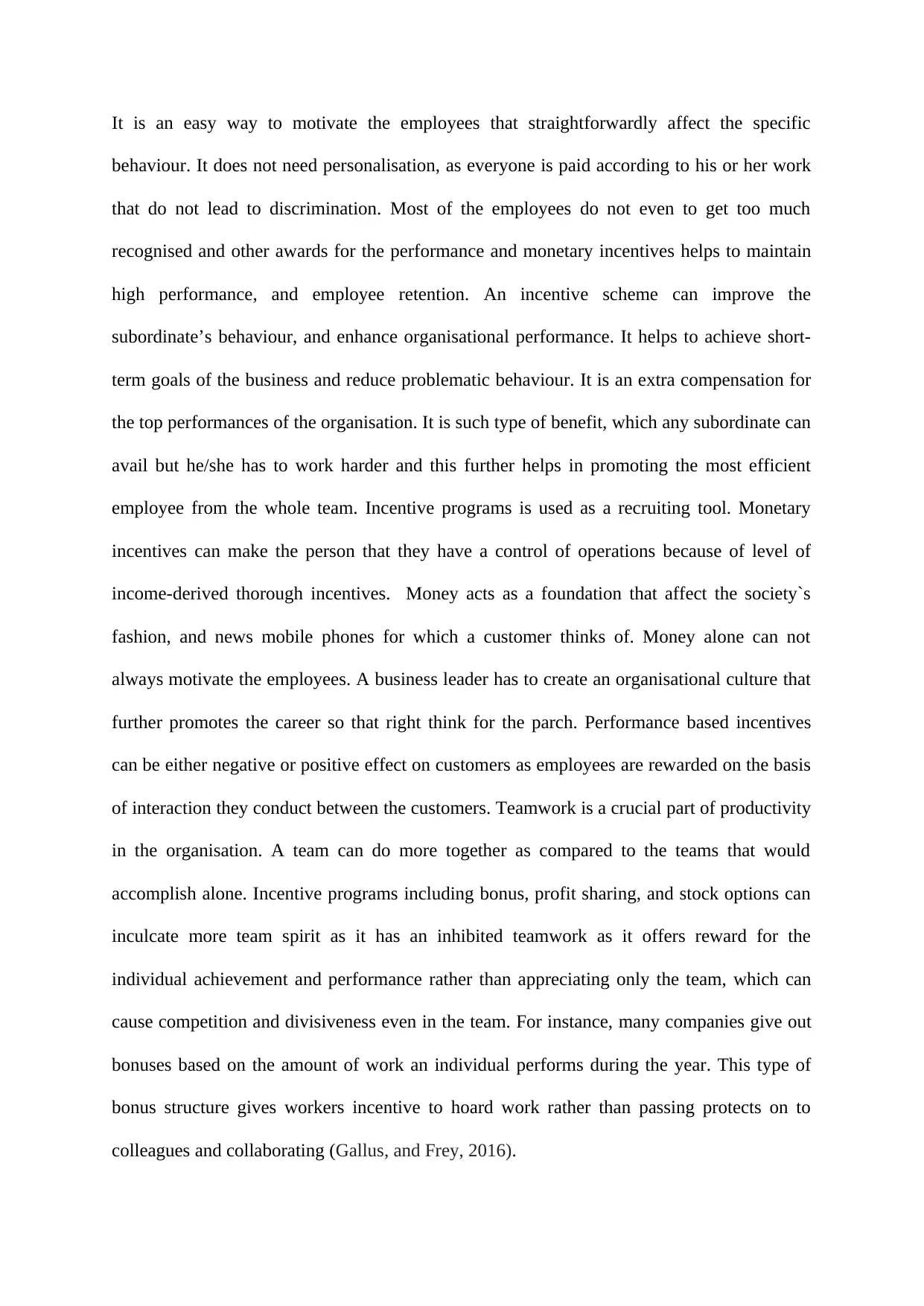
It is an easy way to motivate the employees that straightforwardly affect the specific
behaviour. It does not need personalisation, as everyone is paid according to his or her work
that do not lead to discrimination. Most of the employees do not even to get too much
recognised and other awards for the performance and monetary incentives helps to maintain
high performance, and employee retention. An incentive scheme can improve the
subordinate’s behaviour, and enhance organisational performance. It helps to achieve short-
term goals of the business and reduce problematic behaviour. It is an extra compensation for
the top performances of the organisation. It is such type of benefit, which any subordinate can
avail but he/she has to work harder and this further helps in promoting the most efficient
employee from the whole team. Incentive programs is used as a recruiting tool. Monetary
incentives can make the person that they have a control of operations because of level of
income-derived thorough incentives. Money acts as a foundation that affect the society`s
fashion, and news mobile phones for which a customer thinks of. Money alone can not
always motivate the employees. A business leader has to create an organisational culture that
further promotes the career so that right think for the parch. Performance based incentives
can be either negative or positive effect on customers as employees are rewarded on the basis
of interaction they conduct between the customers. Teamwork is a crucial part of productivity
in the organisation. A team can do more together as compared to the teams that would
accomplish alone. Incentive programs including bonus, profit sharing, and stock options can
inculcate more team spirit as it has an inhibited teamwork as it offers reward for the
individual achievement and performance rather than appreciating only the team, which can
cause competition and divisiveness even in the team. For instance, many companies give out
bonuses based on the amount of work an individual performs during the year. This type of
bonus structure gives workers incentive to hoard work rather than passing protects on to
colleagues and collaborating (Gallus, and Frey, 2016).
behaviour. It does not need personalisation, as everyone is paid according to his or her work
that do not lead to discrimination. Most of the employees do not even to get too much
recognised and other awards for the performance and monetary incentives helps to maintain
high performance, and employee retention. An incentive scheme can improve the
subordinate’s behaviour, and enhance organisational performance. It helps to achieve short-
term goals of the business and reduce problematic behaviour. It is an extra compensation for
the top performances of the organisation. It is such type of benefit, which any subordinate can
avail but he/she has to work harder and this further helps in promoting the most efficient
employee from the whole team. Incentive programs is used as a recruiting tool. Monetary
incentives can make the person that they have a control of operations because of level of
income-derived thorough incentives. Money acts as a foundation that affect the society`s
fashion, and news mobile phones for which a customer thinks of. Money alone can not
always motivate the employees. A business leader has to create an organisational culture that
further promotes the career so that right think for the parch. Performance based incentives
can be either negative or positive effect on customers as employees are rewarded on the basis
of interaction they conduct between the customers. Teamwork is a crucial part of productivity
in the organisation. A team can do more together as compared to the teams that would
accomplish alone. Incentive programs including bonus, profit sharing, and stock options can
inculcate more team spirit as it has an inhibited teamwork as it offers reward for the
individual achievement and performance rather than appreciating only the team, which can
cause competition and divisiveness even in the team. For instance, many companies give out
bonuses based on the amount of work an individual performs during the year. This type of
bonus structure gives workers incentive to hoard work rather than passing protects on to
colleagues and collaborating (Gallus, and Frey, 2016).
⊘ This is a preview!⊘
Do you want full access?
Subscribe today to unlock all pages.

Trusted by 1+ million students worldwide
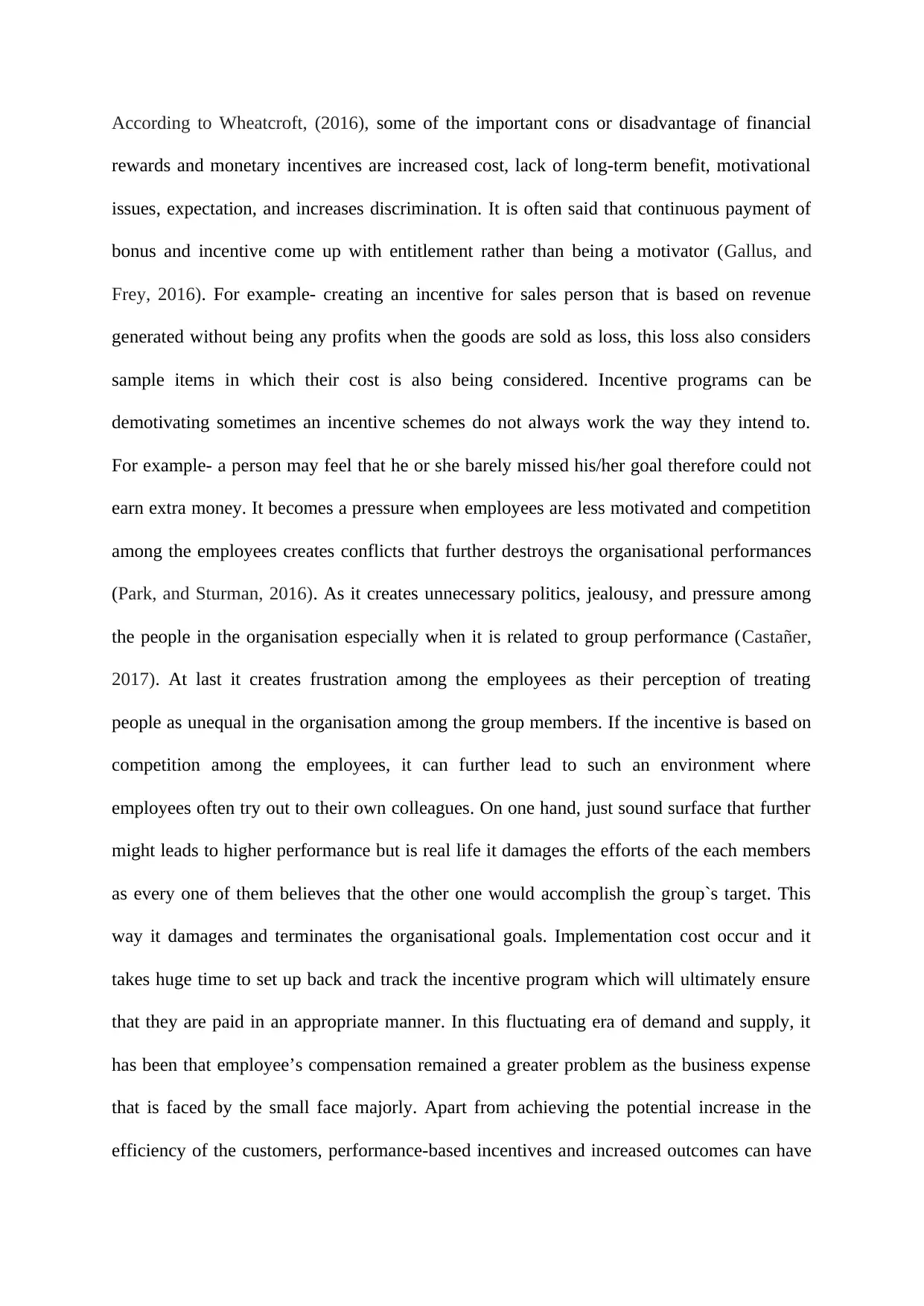
According to Wheatcroft, (2016), some of the important cons or disadvantage of financial
rewards and monetary incentives are increased cost, lack of long-term benefit, motivational
issues, expectation, and increases discrimination. It is often said that continuous payment of
bonus and incentive come up with entitlement rather than being a motivator (Gallus, and
Frey, 2016). For example- creating an incentive for sales person that is based on revenue
generated without being any profits when the goods are sold as loss, this loss also considers
sample items in which their cost is also being considered. Incentive programs can be
demotivating sometimes an incentive schemes do not always work the way they intend to.
For example- a person may feel that he or she barely missed his/her goal therefore could not
earn extra money. It becomes a pressure when employees are less motivated and competition
among the employees creates conflicts that further destroys the organisational performances
(Park, and Sturman, 2016). As it creates unnecessary politics, jealousy, and pressure among
the people in the organisation especially when it is related to group performance (Castañer,
2017). At last it creates frustration among the employees as their perception of treating
people as unequal in the organisation among the group members. If the incentive is based on
competition among the employees, it can further lead to such an environment where
employees often try out to their own colleagues. On one hand, just sound surface that further
might leads to higher performance but is real life it damages the efforts of the each members
as every one of them believes that the other one would accomplish the group`s target. This
way it damages and terminates the organisational goals. Implementation cost occur and it
takes huge time to set up back and track the incentive program which will ultimately ensure
that they are paid in an appropriate manner. In this fluctuating era of demand and supply, it
has been that employee’s compensation remained a greater problem as the business expense
that is faced by the small face majorly. Apart from achieving the potential increase in the
efficiency of the customers, performance-based incentives and increased outcomes can have
rewards and monetary incentives are increased cost, lack of long-term benefit, motivational
issues, expectation, and increases discrimination. It is often said that continuous payment of
bonus and incentive come up with entitlement rather than being a motivator (Gallus, and
Frey, 2016). For example- creating an incentive for sales person that is based on revenue
generated without being any profits when the goods are sold as loss, this loss also considers
sample items in which their cost is also being considered. Incentive programs can be
demotivating sometimes an incentive schemes do not always work the way they intend to.
For example- a person may feel that he or she barely missed his/her goal therefore could not
earn extra money. It becomes a pressure when employees are less motivated and competition
among the employees creates conflicts that further destroys the organisational performances
(Park, and Sturman, 2016). As it creates unnecessary politics, jealousy, and pressure among
the people in the organisation especially when it is related to group performance (Castañer,
2017). At last it creates frustration among the employees as their perception of treating
people as unequal in the organisation among the group members. If the incentive is based on
competition among the employees, it can further lead to such an environment where
employees often try out to their own colleagues. On one hand, just sound surface that further
might leads to higher performance but is real life it damages the efforts of the each members
as every one of them believes that the other one would accomplish the group`s target. This
way it damages and terminates the organisational goals. Implementation cost occur and it
takes huge time to set up back and track the incentive program which will ultimately ensure
that they are paid in an appropriate manner. In this fluctuating era of demand and supply, it
has been that employee’s compensation remained a greater problem as the business expense
that is faced by the small face majorly. Apart from achieving the potential increase in the
efficiency of the customers, performance-based incentives and increased outcomes can have
Paraphrase This Document
Need a fresh take? Get an instant paraphrase of this document with our AI Paraphraser
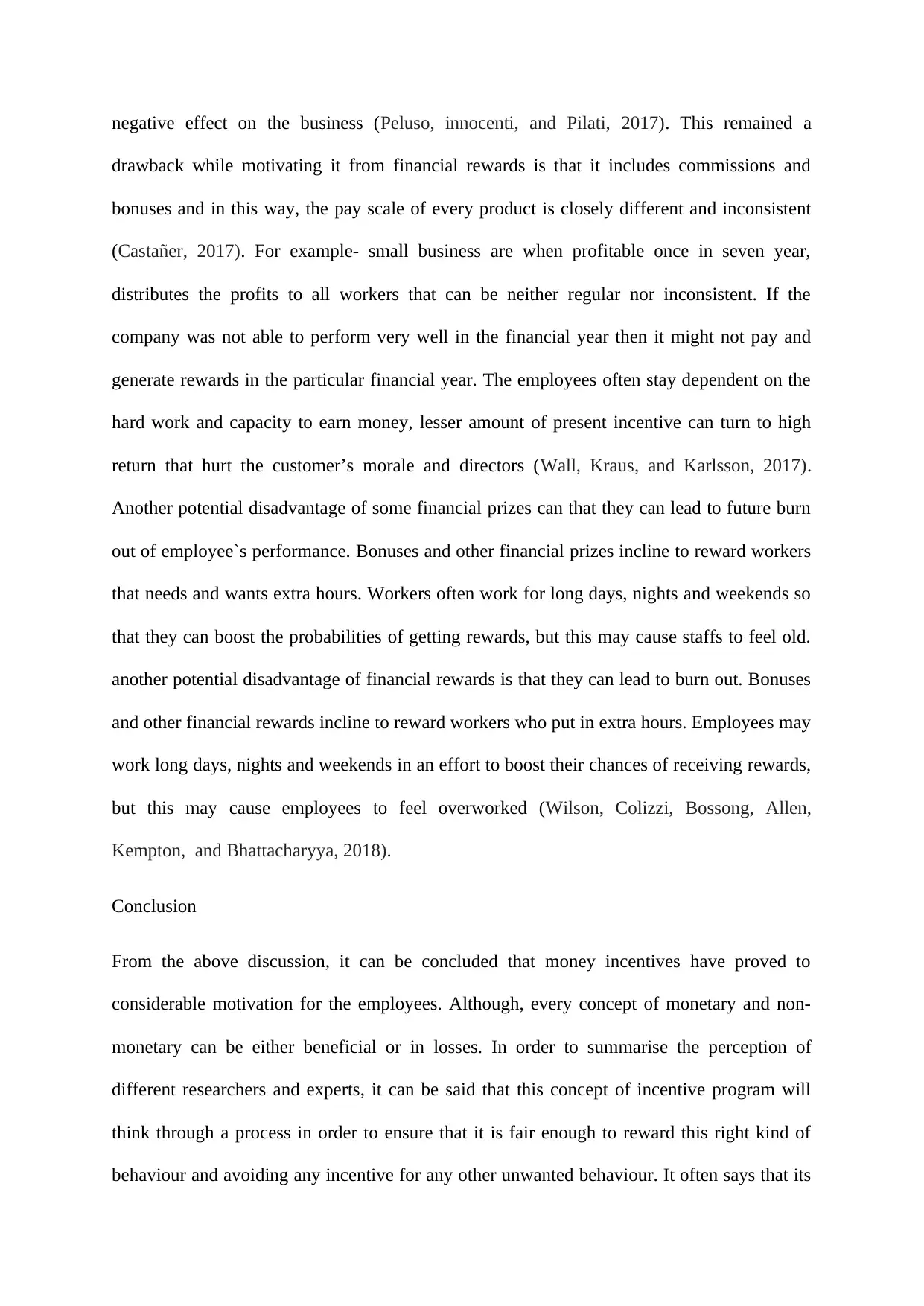
negative effect on the business (Peluso, innocenti, and Pilati, 2017). This remained a
drawback while motivating it from financial rewards is that it includes commissions and
bonuses and in this way, the pay scale of every product is closely different and inconsistent
(Castañer, 2017). For example- small business are when profitable once in seven year,
distributes the profits to all workers that can be neither regular nor inconsistent. If the
company was not able to perform very well in the financial year then it might not pay and
generate rewards in the particular financial year. The employees often stay dependent on the
hard work and capacity to earn money, lesser amount of present incentive can turn to high
return that hurt the customer’s morale and directors (Wall, Kraus, and Karlsson, 2017).
Another potential disadvantage of some financial prizes can that they can lead to future burn
out of employee`s performance. Bonuses and other financial prizes incline to reward workers
that needs and wants extra hours. Workers often work for long days, nights and weekends so
that they can boost the probabilities of getting rewards, but this may cause staffs to feel old.
another potential disadvantage of financial rewards is that they can lead to burn out. Bonuses
and other financial rewards incline to reward workers who put in extra hours. Employees may
work long days, nights and weekends in an effort to boost their chances of receiving rewards,
but this may cause employees to feel overworked (Wilson, Colizzi, Bossong, Allen,
Kempton, and Bhattacharyya, 2018).
Conclusion
From the above discussion, it can be concluded that money incentives have proved to
considerable motivation for the employees. Although, every concept of monetary and non-
monetary can be either beneficial or in losses. In order to summarise the perception of
different researchers and experts, it can be said that this concept of incentive program will
think through a process in order to ensure that it is fair enough to reward this right kind of
behaviour and avoiding any incentive for any other unwanted behaviour. It often says that its
drawback while motivating it from financial rewards is that it includes commissions and
bonuses and in this way, the pay scale of every product is closely different and inconsistent
(Castañer, 2017). For example- small business are when profitable once in seven year,
distributes the profits to all workers that can be neither regular nor inconsistent. If the
company was not able to perform very well in the financial year then it might not pay and
generate rewards in the particular financial year. The employees often stay dependent on the
hard work and capacity to earn money, lesser amount of present incentive can turn to high
return that hurt the customer’s morale and directors (Wall, Kraus, and Karlsson, 2017).
Another potential disadvantage of some financial prizes can that they can lead to future burn
out of employee`s performance. Bonuses and other financial prizes incline to reward workers
that needs and wants extra hours. Workers often work for long days, nights and weekends so
that they can boost the probabilities of getting rewards, but this may cause staffs to feel old.
another potential disadvantage of financial rewards is that they can lead to burn out. Bonuses
and other financial rewards incline to reward workers who put in extra hours. Employees may
work long days, nights and weekends in an effort to boost their chances of receiving rewards,
but this may cause employees to feel overworked (Wilson, Colizzi, Bossong, Allen,
Kempton, and Bhattacharyya, 2018).
Conclusion
From the above discussion, it can be concluded that money incentives have proved to
considerable motivation for the employees. Although, every concept of monetary and non-
monetary can be either beneficial or in losses. In order to summarise the perception of
different researchers and experts, it can be said that this concept of incentive program will
think through a process in order to ensure that it is fair enough to reward this right kind of
behaviour and avoiding any incentive for any other unwanted behaviour. It often says that its
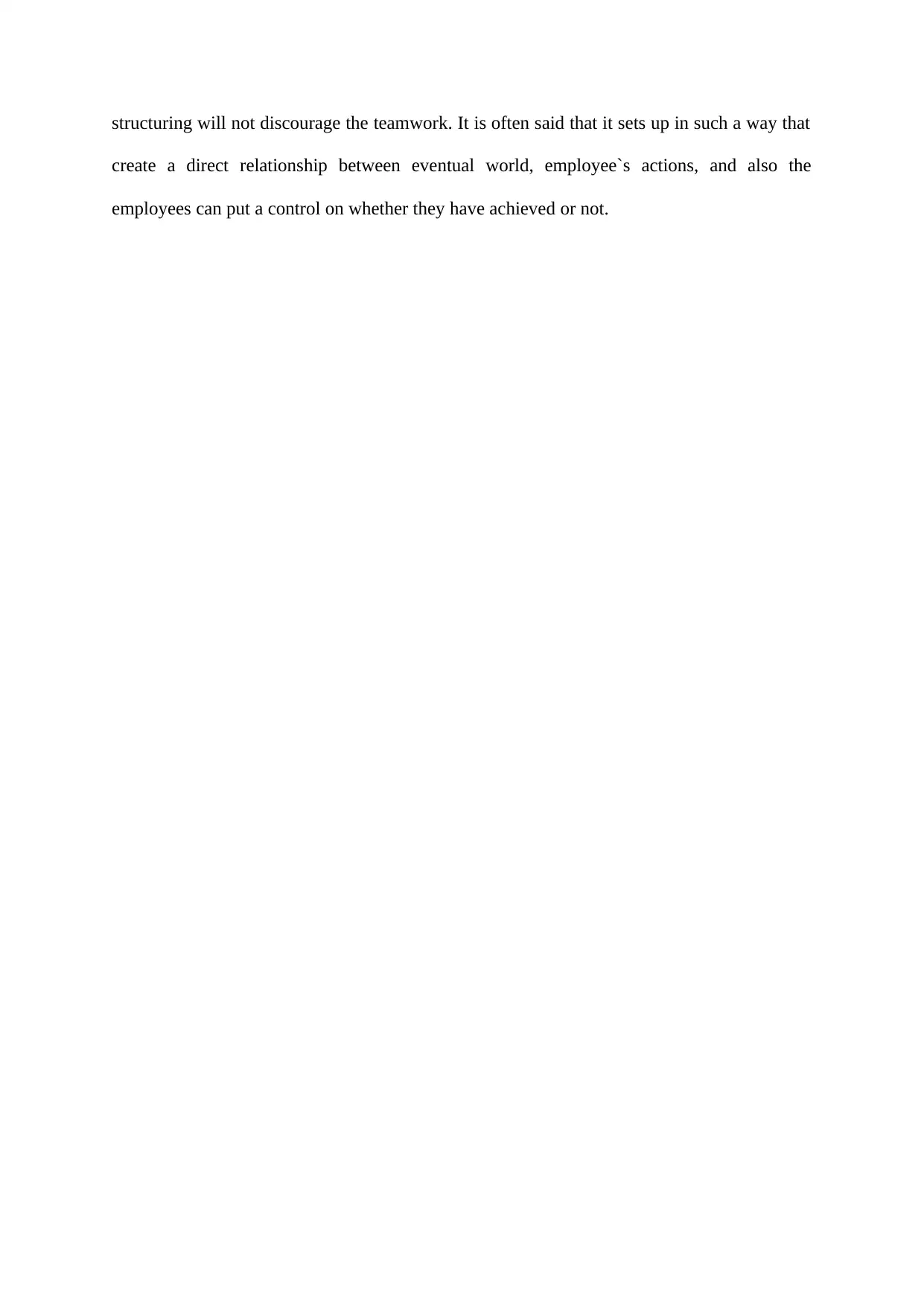
structuring will not discourage the teamwork. It is often said that it sets up in such a way that
create a direct relationship between eventual world, employee`s actions, and also the
employees can put a control on whether they have achieved or not.
create a direct relationship between eventual world, employee`s actions, and also the
employees can put a control on whether they have achieved or not.
⊘ This is a preview!⊘
Do you want full access?
Subscribe today to unlock all pages.

Trusted by 1+ million students worldwide
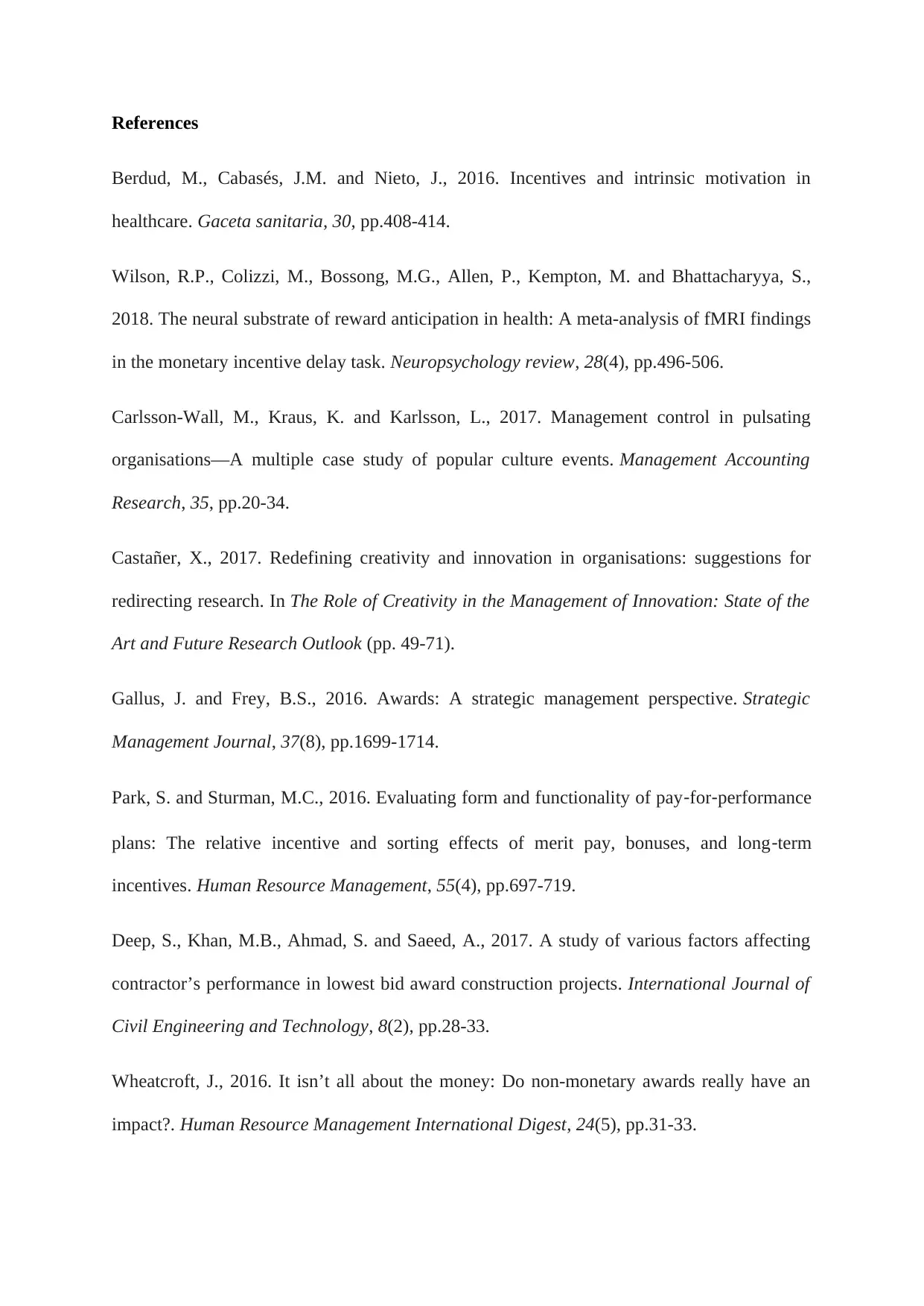
References
Berdud, M., Cabasés, J.M. and Nieto, J., 2016. Incentives and intrinsic motivation in
healthcare. Gaceta sanitaria, 30, pp.408-414.
Wilson, R.P., Colizzi, M., Bossong, M.G., Allen, P., Kempton, M. and Bhattacharyya, S.,
2018. The neural substrate of reward anticipation in health: A meta-analysis of fMRI findings
in the monetary incentive delay task. Neuropsychology review, 28(4), pp.496-506.
Carlsson-Wall, M., Kraus, K. and Karlsson, L., 2017. Management control in pulsating
organisations—A multiple case study of popular culture events. Management Accounting
Research, 35, pp.20-34.
Castañer, X., 2017. Redefining creativity and innovation in organisations: suggestions for
redirecting research. In The Role of Creativity in the Management of Innovation: State of the
Art and Future Research Outlook (pp. 49-71).
Gallus, J. and Frey, B.S., 2016. Awards: A strategic management perspective. Strategic
Management Journal, 37(8), pp.1699-1714.
Park, S. and Sturman, M.C., 2016. Evaluating form and functionality of pay‐for‐performance
plans: The relative incentive and sorting effects of merit pay, bonuses, and long‐term
incentives. Human Resource Management, 55(4), pp.697-719.
Deep, S., Khan, M.B., Ahmad, S. and Saeed, A., 2017. A study of various factors affecting
contractor’s performance in lowest bid award construction projects. International Journal of
Civil Engineering and Technology, 8(2), pp.28-33.
Wheatcroft, J., 2016. It isn’t all about the money: Do non-monetary awards really have an
impact?. Human Resource Management International Digest, 24(5), pp.31-33.
Berdud, M., Cabasés, J.M. and Nieto, J., 2016. Incentives and intrinsic motivation in
healthcare. Gaceta sanitaria, 30, pp.408-414.
Wilson, R.P., Colizzi, M., Bossong, M.G., Allen, P., Kempton, M. and Bhattacharyya, S.,
2018. The neural substrate of reward anticipation in health: A meta-analysis of fMRI findings
in the monetary incentive delay task. Neuropsychology review, 28(4), pp.496-506.
Carlsson-Wall, M., Kraus, K. and Karlsson, L., 2017. Management control in pulsating
organisations—A multiple case study of popular culture events. Management Accounting
Research, 35, pp.20-34.
Castañer, X., 2017. Redefining creativity and innovation in organisations: suggestions for
redirecting research. In The Role of Creativity in the Management of Innovation: State of the
Art and Future Research Outlook (pp. 49-71).
Gallus, J. and Frey, B.S., 2016. Awards: A strategic management perspective. Strategic
Management Journal, 37(8), pp.1699-1714.
Park, S. and Sturman, M.C., 2016. Evaluating form and functionality of pay‐for‐performance
plans: The relative incentive and sorting effects of merit pay, bonuses, and long‐term
incentives. Human Resource Management, 55(4), pp.697-719.
Deep, S., Khan, M.B., Ahmad, S. and Saeed, A., 2017. A study of various factors affecting
contractor’s performance in lowest bid award construction projects. International Journal of
Civil Engineering and Technology, 8(2), pp.28-33.
Wheatcroft, J., 2016. It isn’t all about the money: Do non-monetary awards really have an
impact?. Human Resource Management International Digest, 24(5), pp.31-33.
Paraphrase This Document
Need a fresh take? Get an instant paraphrase of this document with our AI Paraphraser
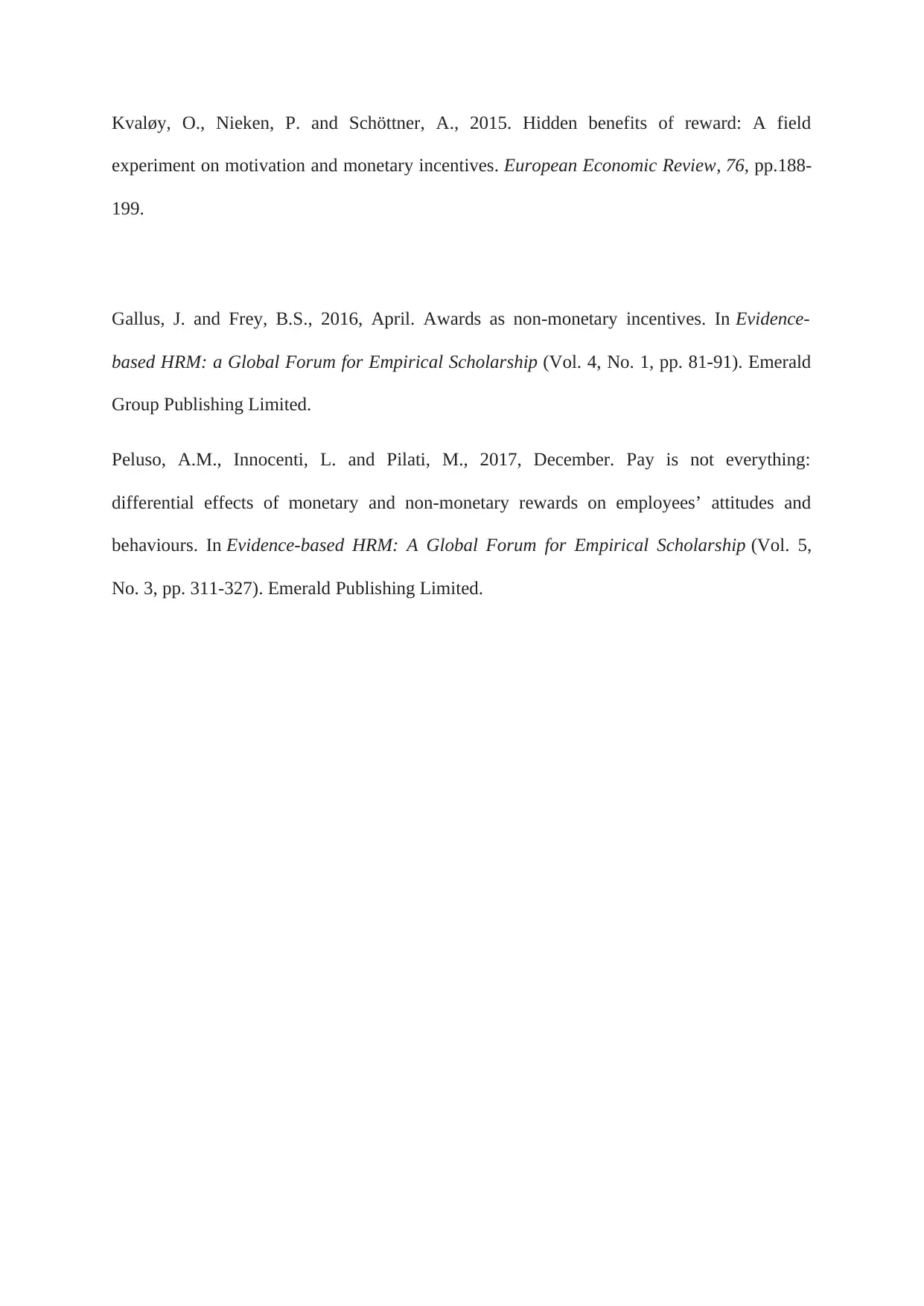
Kvaløy, O., Nieken, P. and Schöttner, A., 2015. Hidden benefits of reward: A field
experiment on motivation and monetary incentives. European Economic Review, 76, pp.188-
199.
Gallus, J. and Frey, B.S., 2016, April. Awards as non-monetary incentives. In Evidence-
based HRM: a Global Forum for Empirical Scholarship (Vol. 4, No. 1, pp. 81-91). Emerald
Group Publishing Limited.
Peluso, A.M., Innocenti, L. and Pilati, M., 2017, December. Pay is not everything:
differential effects of monetary and non-monetary rewards on employees’ attitudes and
behaviours. In Evidence-based HRM: A Global Forum for Empirical Scholarship (Vol. 5,
No. 3, pp. 311-327). Emerald Publishing Limited.
experiment on motivation and monetary incentives. European Economic Review, 76, pp.188-
199.
Gallus, J. and Frey, B.S., 2016, April. Awards as non-monetary incentives. In Evidence-
based HRM: a Global Forum for Empirical Scholarship (Vol. 4, No. 1, pp. 81-91). Emerald
Group Publishing Limited.
Peluso, A.M., Innocenti, L. and Pilati, M., 2017, December. Pay is not everything:
differential effects of monetary and non-monetary rewards on employees’ attitudes and
behaviours. In Evidence-based HRM: A Global Forum for Empirical Scholarship (Vol. 5,
No. 3, pp. 311-327). Emerald Publishing Limited.
1 out of 8
Related Documents
Your All-in-One AI-Powered Toolkit for Academic Success.
+13062052269
info@desklib.com
Available 24*7 on WhatsApp / Email
![[object Object]](/_next/static/media/star-bottom.7253800d.svg)
Unlock your academic potential
Copyright © 2020–2025 A2Z Services. All Rights Reserved. Developed and managed by ZUCOL.





